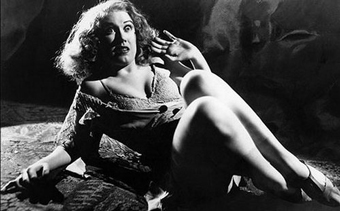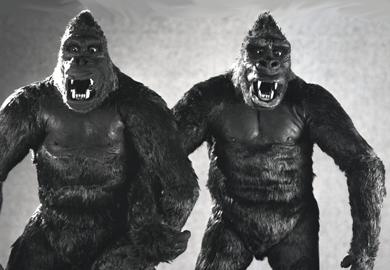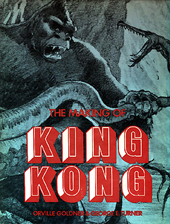
 |
|
|
|
I reviewed Warner's excellent King Kong Special Edition DVD in 2005 and still like what I wrote about the movie there, more or less. That review is recommended as an enthusiasm-booster before seeing the studio's new follow-up King Kong Blu-ray. I'd rather use this space to spin off in a new discussion of everyone's favorite giant movie monster, and then take a look at the new Blu-ray's transfer and extras. King Kong is a good, old-fashioned American creation. He emerged from the gloomy bottom of the Great Depression to reinvent film Horror as a modern item unrelated to ancient superstitions or primitive folklore. The Skull Islanders worship their monster god but we know that he's a colossal joke played by Charles Darwin -- the fossil bones discovered by all those dry professors are suddenly alive and kicking, and ready to bite. Kong's status as a modern myth is well-earned, as no movie monster before or since is as interpretable in terms of social politics, -isms and artistic innovations. The 20th century with its mechanized wars, towering cities and out of control economies seemingly came falling down with the Stock Market crash, a near-cosmic event that brought chaos to our cities. If the economy and the government no longer function, what will? The world of art and literature had been predicting this chaos ever since the Armistice. Everybody had heard of Surrealism but few knew anything about it, except that it involved shocking people and outraging accepted standards of decency (as did all good ideas in the 1920s). 
King Kong wasn't made by an artistic elite but by conservative adventurers, practical men who knew well the commercial reality of filmmaking. They were acutely aware of the wild, dangerous world out there away from the streets of New York, and we have to think that the idea of primitive monsters wreaking havoc in the capital of Men was their own unconscious surreal statement. The sight of a thirty-foot gorilla crushing New Yorkers underfoot as it tears up the 3rd Avenue El is the kind of fever dream that would excite a surrealist like Luis Buñuel, who wanted nothing more than to give complacent viewers (and their narrow opinions) a damn good shaking-up. Surrealists loved Horror and the Uncanny as represented by cinema ghouls like Nosferatu; King Kong brought the fear up to date. Instead of far away in some mittel-European castle, this monster was just a few blocks downtown, smashing windows and chasing your brother-in-law up 42nd Street. The most intimately horrific moment in King Kong occurs in one of the famous cut/restored scenes. While searching for Ann Darrow the giant ape spots another woman in her bed, fifteen floors up some building. Imagine the scene from the woman's point of view. She's asleep, completely unaware of anything, when she finds herself upside-down in the gorilla's paw, suspended high above the street. A couple of seconds later, she plummets to her doom, never understanding what possibly could have happened to her. The scariest aspect of this is that what happens is so "impossible" that she might easily think that she's still dreaming, that the beast is just another figment of her unconsciousness. I've seen King Kong seriously debated as an allegory about black slavery, with the 'savage' black man brought in chains to America and mercilessly hunted down when he rebels. Not really thought through, this idea forgets how racist a conception that would have to be, as the black monster is done in by his lust for a golden haired white woman. If Kong is about a lynching, it's a really ugly allegory. A more general Third World interpretation puts forward the notion that civilization is evil for exploiting the underdeveloped regions of the world. Claiming that Kong was conceived to represent a political backlash against Yankee Imperialism is more than a little ridiculous. The makers had no such notions (at least not consciously) and the habit of linking political struggles to pop culture wasn't as developed then as it is now, when every movie about mass destruction is burdened with anti-something interpretations. King Kong is not Che Guevara. For purely sentimental reasons, I personally accept King Kong as a key representative of his times, those times being the Depression. The situation is dire for women like Ann Darrow and also for hotshots like Carl Denham, who must steal out of port because he can't let the authorities see his cargo of guns and gas bombs. Denham returns with a fine evening's entertainment for New York's rich theater-goers. Cheering up big despair requires big entertainments, and the stuffed tuxedoes and slinky gowns treated to Kong's opening night are ready to see something unforgettable. But for once, a lavish entertainment isn't content to remain a passive curiosity -- this Denham show explodes in the faces of its audience like killer 3D. Kong's urban rampage is there to tell us that nobody is in charge: like a force of savage nature, the giant monster will smash anything and anybody, regardless of what's in your bank account. America is being punished for its own hubris. The Big Apple may say "Yes" to higher civilization but Kong will have his one night to roar a "No" of defiance at the humans that persecute him. A 60s hippie button (we didn't have much T-shirt art back then) proclaimed: "King Kong Died for Your Sins". Getting back into the film's actual legacy, we need to remember that original studio publicity purposely avoided explaining the technical wizardry behind Kong's then-revolutionary special effects. An illustrated 'expose' in a popular science magazine perpetuated the idea that Kong had been played by a man in a suit. Movie effects back then were not on anybody's mind and it's probable that few even in the RKO front office knew much about how the film's illusions were done. Many craftsmen understood, of course, but as far as the public was concerned the cat stayed in the bag until the late 1950s, when Famous Monsters magazine started an entire generation of young boys thinking about special effects. (See my old Savant article The Hollywood Children of Ray Harryhausen.) I remember tuning in to a local Los Angeles afternoon movie program around 1980, where the host explained that Kong had been played by a man in a gorilla suit. Either David Allen or Jim Danforth, I forget which, immediately called in to correct the error. 
King Kong's effects stayed state-of-the-art for at least 25 years, when Ray Harryhausen introduced color into his improved 'reality sandwich' split screen stop-motion effects. Harryhausen's 'edge' over Kong effects man Willis O'Brien was his good luck with practical show-biz realities. O'Brien was a studio employee type who needed a visionary like Merian C. Cooper to believe in his special effects visions. After two or three more effects shows Cooper moved on to other interests, leaving O'Brien a studio department head unable to interest the front office in his grandiose film ideas. They all seemed too complex and too expensive. When O'Brien's apprentice Harryhausen figured out how to produce the same illusions all on his own, without studio resources, he attracted a dedicated producer and built his own career. O'Brien would be abused by a series of producers that stole his ideas or bought them cheaply and gave them to others to complete. O'Brien ended up doing work for hire on just two or three monster movies, never with any creative control and always a step below Harryhausen's in overall quality. One thing that audiences finally seem to have caught on to, is that there's nothing incompetent about King Kong's script or performances. Many of us 70s college students had the pea-brained notion that we were the first really cool and aware generation (hah!) and that clunky old movies were only good for a laugh. In 1933 jungle adventure movies had already been a major trend for several years, what with Trader Horn and the Tarzan franchise. Anybody really watching the early scenes can catch the film's slightly tongue-in-cheek tone, in both Carl Denham's "bring 'em back alive" fanaticism ("Crazy?""No, just enthusiastic!") and in the sentimental romance between Darrow and John Driscoll: "Gee ... I guess I love you!" These scenes are amusing, and were intended as such. These complexities from a different era (going on eighty years ago) only serve to further embellish the fantastic achievement of King Kong. Under Willis O'Brien's guidance, RKO's technical departments invented scores of new technologies just for the one picture, and the film's illusions still impress with their expressive deep-jungle designs and their essential vitality. Skull Island is a truly magical land lost in time, a place synonymous with the dream of adventure. I hold no grudge whatsoever against Peter Jackson's 2005 remake but there's no substitute for an original work of popular art -- the '33 Kong is the one that activates the subconscious, stirs one's imagination and remains a masterpiece of spectacle, horror and adventure. Warner Home Video's Blu-ray of King Kong gives us a carefully mastered HD version of the transfer seen back on Standard Def back in 2005, complete with the rediscovered musical overture. As one expects with Blu-ray, the picture seems more stable and the contrast range is improved. Overall sharpness is better too. I thought the 2005 DVD was overly grainy in places and I have the same comment here. Scenes set in fog and shot with diffusion filters have more grain than they should. I've read a couple of reviews that say the BD isn't a big improvement on the old SD disc, which I can only interpret as coming from people who still expect a 1933 movie to look and sound like one from 2010. For me the improvement is immediate and obvious. The increased detail brings back memories of theatrical showings in 35mm, where we'd sit there watching with our mouths hanging open. Nothing like this was being made in the 1970s. 1 The Blu-ray ports over most of the extras from the 2005 release, all up-rezzed to BD. The audio commentary is from Ray Harryhausen and effects supervisor Ken Ralston, with edited input from producer Merian C. Cooper and Fay Wray. The espansive multi-part making-of docu RKO Production 601 is here as well, along with the fascinating hour-long Kevin Brownlow docu on Cooper, I'm King Kong! All of these extras look better than they did on the DVD. RKO Production 601 is so much sharper that I have to believe it was originally post-finished in HD. Also present is the animation reel from the aborted Creation project narrated by Ray Harryhausen, along with the stand-alone re-creation of the Lost Spider Pit Sequence. 
Warners' book packaging contains a beautiful 32-page souvenir booklet with text by Rudy Behlmer, an expert on Hollywood history unappreciated by the new generation of Criterion commentators. Behlmer's essay is packed with interesting information and opinions, like a quick-study version of the great old Turner-Goldner book on the making of Kong. The illustrations and art are good too; this is much better than Warners' usual publicity-oriented insert books. My favorite item is still the episode of Production 601 about Peter Jackson and WETA researching and re-creating the lost Spider Pit Scene, in new stop-motion animation. It's fun to see Jackson's people working on the puppets. The only difference between the disc releases is the absence of a Merian C. Cooper trailer collection. Most of the films in the stack were John Ford westerns; the Kong trailer is retained by itself.
On a scale of Excellent, Good, Fair, and Poor,
King Kong Blu-ray rates:
Footnote:
1. In the 1970s Kong would play repertory houses (with prints from Janus?). In a typical showing, most of the reels would look so-so, and then a changeover might bring up what looked to be an original reel from the 1952 reissue, in perfect shape. Across a cut, the picture and sound quality improved ten-fold, giving us a sampling of what the movie was like 'back in the day': breathtaking.
Reviews on the Savant main site have additional credits information and are often updated and annotated with reader input and graphics. Also, don't forget the 2010 Savant Wish List. T'was Ever Thus.
Review Staff | About DVD Talk | Newsletter Subscribe | Join DVD Talk Forum |
| ||||||||||||||||||